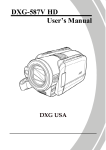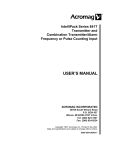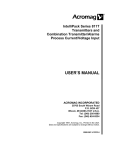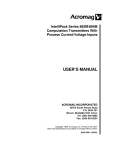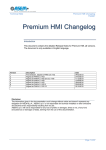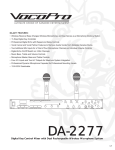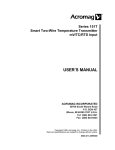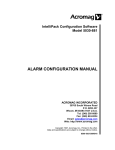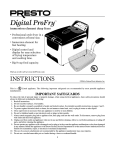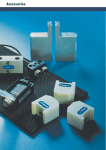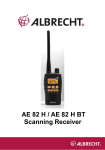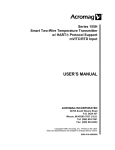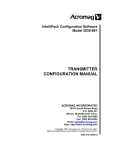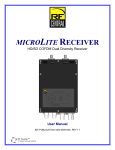Download 801T IntelliPack Transmitter
Transcript
IntelliPack Series 801T Transmitters and Combination Transmitter/Alarms mV/TC/RTD Input USER’S MANUAL ACROMAG INCORPORATED 30765 South Wixom Road P.O. BOX 437 Wixom, MI 48393-7037 U.S.A. Tel: (248) 295-0880 Fax: (248) 624-9234 Web: http://www.acromag.com Email: [email protected] Copyright 1997, Acromag, Inc., Printed in the USA. Data and specifications are subject to change without notice. 8500-568-H09H031 IntelliPack Series 801T Transmitter/Alarm User’s Manual mV/TC/RTD Input ___________________________________________________________________________________________ Safety Summary - Symbols on equipment: IMPORTANT SAFETY CONSIDERATIONS ! Means “Caution, refer to this manual for additional information”. The information contained in this manual is subject to change without notice. Acromag, Inc., makes no warranty of any kind with regard to this material, including, but not limited to, the implied warranties of merchantability and fitness for a particular purpose. Further, Acromag, Inc., assumes no responsibility for any errors that may appear in this manual and makes no commitment to update, or keep current, the information contained in this manual. No part of this manual may be copied or reproduced in any form, without the prior written consent of Acromag, Inc. Table of Contents 1.0 INTRODUCTION ………………………………..…….. DESCRIPTION ………………………………………… Key IntelliPack 801T Features……………………… ACCESSORY ITEMS …………………………………. IntelliPack Configuration Software ...……………… IntelliPack Serial Port Adapter …………………….. IntelliPack Cable………………………….………….. IntelliPack Software Interface Package…..……….. AC Current Sensor ………………………………….. 2.0 PREPARATION FOR USE ….……………………….. UNPACKING AND INSPECTION …………………… INSTALLATION ……………………………………….. Jumper Installation (For Voltage Output Only)…… Mounting ……………………………………………… Electrical Connections ……………………………… 3.0 MODULE CONFIGURATION ……………………….. FIELD CALIBRATION/CONFIGURATION …………. 4.0 THEORY OF OPERATION ………………………….. 5.0 SERVICE AND REPAIR ……………………………… SERVICE AND REPAIR ASSISTANCE ……………. PRELIMINARY SERVICE PROCEDURE ..…………. 6.0 SPECIFICATIONS ……………………………………. MODEL NUMBER DEFINITION……………………… INPUT SPECIFICATIONS ……………………………. ANALOG OUTPUT SPECIFICATIONS……………… RELAY OUTPUT SPECIFICATIONS……………….. ENCLOSURE/PHYSICAL SPECIFICATIONS …….. APPROVALS ………………………………………….. ENVIRONMENTAL SPECIFICATIONS….………….. FIELD CONFIGURATION AND CONTROLS..……... HOST COMPUTER COMMUNICATION……..……… SOFTWARE CONFIGURATION……..…………….… List of Drawings Simplified Schematic (4501-680)……………………….… Functional Block Diagram (4501-689)………….………… Computer to IntelliPack Connections (4501-643) ………. Electrical Connections (4501-681)……..………….…..…. Interposing Relay Conn. & Contact Pro. (4501-646)……. Enclosure Dimensions (4501-642) …………………..…… It is very important for the user to consider the possible adverse effects of power, wiring, component, sensor, or software failures in designing any type of control or monitoring system. This is especially important where economic property loss or human life is involved. It is important that the user employ satisfactory overall system design. It is agreed between the Buyer and Acromag, that this is the Buyer's responsibility. 1.0 INTRODUCTION These instructions cover hardware functionality of the transmitter models listed in Table 1. Supplementary sheets are attached for units with special options or features. Table 1: Models Covered in This Manual -Factory Series/ -Options/Output/ Input/Type Enclosure/Approvals1 Configuration2 801T -05003 -C 801T -15003 -C Page 2 2 3 4 4 4 4 4 4 4 4 4 5 5 5 5 6 7 7 7 7 8 8 8 9 10 10 10 10 11 11 11 Notes (Table 1): 1. Agency approvals include CE, UL Listed, and cUL Listed. 2. Include the “-C” suffix to specify factory configuration option. Otherwise, no suffix is required for standard configuration. 3. Model 801T-0500 units have transmitter functionality only, while 801T-1500 transmitters include an alarm relay. Module programming, transmitter operation, and the IntelliPack Configuration Software is covered in the IntelliPack Transmitter Configuration Manual (8500-570). DESCRIPTION Series 801T Transmitters and combination Transmitter/ Alarms are members of the popular Acromag IntelliPack transmitter & alarm family. These models will condition DC voltage, thermocouple, or RTD inputs. The transmitter output is an isolated process current or voltage, plus an optional SinglePole Double-Throw (SPDT) electro-mechanical alarm relay (Model 801T-1500). All IntelliPacks contain an advanced technology microcontroller with integrated downloadable flash memory and EEPROM for non-volatile program, configuration, calibration, and parameter data storage. Units are fully reconfigurable via our user-friendly Windows 95® or NT® IntelliPack Configuration Program. Field reconfigurability is also possible with module push-buttons and status LED’s. Once configured, these modules may operate independent of the host computer for true embedded monitoring and control. Page 13 14 15 16 17 18 Each module provides a single input for either DC millivolts, thermocouple, or RTD signals. RTD sensor excitation, linearization, lead-wire compensation, and lead break detection are included. Thermocouple reference-junction compensation, linearization, and open circuit or TC break detection is also provided. Model 801T Transmitters provide an isolated process current or voltage output and Model 801T-1500 units include an isolated alarm relay. The relay has a yellow LED on the front of the module that provides a visual indication of the high or low alarm condition. Additionally, green “Run”, yellow “Status”, and “Zero/Full-Scale” LED’s provide local feedback of operating mode, system diagnostics, and field configuration status. Windows 95 & NT are registered trademarks of Microsoft Corp. -2- IntelliPack Series 801T Transmitter/Alarm User's Manual mV/TC/RTD Input ___________________________________________________________________________________________ Front panel push buttons are available to reset a latched alarm and to facilitate field configuration without connecting to a host computer. Key IntelliPack 801T Features…continued • Fully Isolated - Input, power, outputs, and relay contacts are all isolated from each other for safety and increased noise immunity. • Wide Input Transfer Function Variability - Proportional, 24 segment linearizer, or square-root transfer function. Averaging may be applied to any input function. Other functions are possible—please consult the factory. • Universal Analog Outputs - Supports process current output ranges of 0-20mA, 4-20mA, and 0-1mA, and 0-5V or 0-10V outputs. Current outputs drive up to 550Ω, typical. Voltage outputs include short-circuit protection. • Normal Or Reverse Acting Output Direction - The output of this transmitter may be software configured for a normal (ascending), or reverse (descending) response. • Flexible DC Millivolt, Thermocouple, or RTD Inputs Accepts either DC millivolt, thermocouple, or RTD input signals. Linearization, lead break detection, and TC reference junction compensation are included. • True 4-Wire Kelvin Measurement - Improves performance of 4-wire RTD measurements. • Self-Diagnostics - Built-in routines operate upon power-up for reliable service, easy maintenance, and troubleshooting. • Wide-Range DC-Powered - This device receives power over a wide DC supply range and the power terminal is diode-coupled. This makes this transmitter useful for systems with redundant supplies, and/or battery back-up. • Wide Ambient Operation - The unit is designed for reliable operation over a wide ambient temperature range. • Hardened For Harsh Environments - The unit will operate reliably in harsh industrial environments and include protection from RFI, EMI, ESD, EFT, and surges, plus low radiated emissions per CE requirements. • Convenient Mounting, Removal, & Replacement - The DIN-rail mount and plug-in type terminal blocks make module removal and replacement easy. • High-Resolution Precise A/D Conversion - Transmitters include a high-resolution, low noise, Sigma-Delta Analog to Digital Converter (Σ-Δ ADC) for high accuracy and reliability. • High-Resolution Precise D/A Conversion - Transmitter output is driven with a high-resolution, low noise, SigmaDelta, Digital-to-Analog Converter (Σ-Δ DAC) for high accuracy and reliability. • LED Indicators - A green LED indicates power. A yellow status LED will turn on if input signal is out of calibrated range. A yellow alarm LED indicates when a relay is in alarm. These LED’s also have other functions in field program mode. A zero/full-scale LED is used to calibrate transmitter zero and full-scale values. • Automatic Self-Calibration - Self-calibration is built-in to correct for temperature drift of the input circuit. The module uses a high resolution, low noise, Sigma-Delta, Analog to Digital Converter (Σ-Δ ADC) to accurately convert the input signal into a digitized value. An optically isolated Digital-toAnalog Converter (DAC) provides the corresponding process current or voltage output. A separate alarm circuit controls the relay contacts. Flexible transmitter functionality and an optional alarm combined in a single device, plus convenient reprogrammability, makes this instrument extremely powerful and useful over a broad range of applications. This transmitter may be configured for several input transfer functions (with millivolt input), such as, proportional, 24-segment linearizer, and square root. Input averaging may also be combined with any function. The output may produce a normal (ascending), or reverse (descending) response. The optional relay of 801T-1500 models may be configured as a limit alarm with deadband, with latching or nonlatching contacts, and for failsafe or non-failsafe modes. A programmed relay time delay may be implemented to filter transients and minimize nuisance alarms. All IntelliPack modules are designed to withstand harsh industrial environments. They feature RFI, EMI, ESD, EFT, and surge protection, plus low temperature drift, wide ambient temperature operation, and isolation between input, power, output, and relay contacts. They also have low radiated emissions per CE requirements. As a wide-range DC-powered device, the unit may be powered from DC power networks incorporating battery backup. Additionally, the input power terminal is diode-coupled, providing reverse polarity protection. This allows the unit to be connected to redundant power supplies, or several units to safely share a single DC supply. Units are DIN-rail mounted and removable terminal blocks facilitate ease of installation and replacement, without having to remove wiring. Transmitter power, output, and relay wiring are inserted at one side of the unit, while input wiring is inserted at the other side. Connectors are an industry standard screw clamp type and accept a wide range of wire sizes. The safe, compact, rugged, reconfigurable, and reliable design of this transmitter makes it an ideal choice for control room and field applications. Custom IntelliPack module configurations are also possible (please consult the factory). Key IntelliPack 801T Features • Agency Approvals - CE, UL Listed, & cUL Listed. • Easy Windows® Configuration - Fully reconfigurable via our user-friendly Windows 95® or NT® IntelliPack Configuration Program. • Nonvolatile Reprogrammable Memory - This module has an advanced technology microcontroller with integrated, non-volatile, downloadable flash memory and EEPROM. This allows the functionality of this device to be reliably reprogrammed thousands of times. • Convenient Field Reprogrammability - This unit allows transmitter zero and span calibration, plus alarm setpoint and deadband adjustments, to be made via module pushbuttons and LED’s, thus facilitating in-field changes without having to connect a host computer. Alarm Relay Models (801T-1500) Only • Optional Alarm Functionality - May be programmed for limit alarms with deadband, latching/non-latching contacts, and failsafe/non-failsafe operation. • High-Power SPDT Relay Contacts - Includes a SinglePole-Double-Throw (SPDT) electromechanical alarm relay for switching voltages to 230VAC at currents up to 5A. • Failsafe or Non-Failsafe Relay Operation - May be configured for failsafe or non-failsafe relay operation. • Configurable Setpoint With Deadband - Includes programmable deadband to help eliminate relay “chatter” and prolong contact life. -3- IntelliPack Series 801T Transmitter/Alarm User's Manual mV/TC/RTD Input ___________________________________________________________________________________________ • • Configurable Latching or Momentary Alarms - May be configured with an automatic alarm reset, or a latching alarm with manual push-button or software reset. Configurable Relay Time Delay Filters Transients Useful for increased noise immunity and to filter transients. 2.0 PREPARATION FOR USE UNPACKING AND INSPECTION Upon receipt of this product, inspect the shipping carton for evidence of mishandling during transit. If the shipping carton is badly damaged or water stained, request that the carrier's agent be present when the carton is opened. If the carrier's agent is absent when the carton is opened and the contents of the carton are damaged, keep the carton and packing material for the agent's inspection. For repairs to a product damaged in shipment, refer to the Acromag Service Policy to obtain return instructions. It is suggested that salvageable shipping cartons and packing material be saved for future use in the event the product must be shipped. ACCESSORY ITEMS The following IntelliPack accessories are available from Acromag. Acromag also offers other standard and custom transmitter and alarm types to serve a wide range of applications (please consult the factory). IntelliPack Configuration Software (Model 5030-881) IntelliPack alarms and transmitters are configured with this user-friendly Windows 95® or NT® Configuration Program. This software package includes the IntelliPack Alarm Configuration Manual (8500-563) and IntelliPack Transmitter Configuration Manual (8500-570). These manuals describe software operation and various alarm and transmitter functions in detail. The Configuration Software also includes an on-line help function. All transmitter and alarm functions are programmable and downloadable to the modules via this software. Non-volatile memory provides program, configuration, and data storage within the IntelliPack. This module is physically protected with packing material and electrically protected with an anti-static bag during shipment. However, it is recommended that the module be visually inspected for evidence of mishandling prior to applying power. This circuit utilizes static sensitive components and should only be handled at a static-safe workstation. IntelliPack Serial Port Adapter (Model 5030-913) This adapter serves as an isolated interface converter between the EIA232 serial port of the host computer and the Serial Peripheral Interface (SPI) port of the IntelliPack module. It is used in conjunction with the Acromag IntelliPack Configuration Software to program and configure the modules. This adapter requires no user adjustment, no external power, and operates transparent to the user. It receives its power from the IntelliPack module. The adapter has a DB9S connector that mates to the common DB9P serial port connector of a host computer. The adapter also has a 6-wire RJ11 phone jack to connect to the IntelliPack alarm module via a separate interconnecting cable (described below). Refer to Drawing 4501-635 for computer to IntelliPack connection details. INSTALLATION The transmitter module is packaged in a general purpose plastic enclosure. Use an auxiliary enclosure to protect the unit in unfavorable environments or vulnerable locations, or to maintain conformance to applicable safety standards. Stay within the specified operating temperature range. As shipped from the factory, the unit is factory calibrated for all valid input ranges and has the default configuration shown in Table 2 below: WARNING: Applicable IEC Safety Standards may require that this device be mounted within an approved metal enclosure or sub-system, particularly for applications with voltages greater than or equal to 75VDC or 50VAC. IntelliPack Cable (Model 5030-902) Table 2: 801T Default Factory Configuration PARAMETER CONFIGURATION/CALIBRATION Input Range J TC Type (-210°C to +760°C) Temp Units °C CJC Enabled Samples N=1 (No Input Averaging) Sensor Break Upscale Output Range 0 to 10V DC (Jumper Installed) Output Mode Normal Acting (Ascending Signal) Transmitter Scaling Input for 0% Output = -210°, Input for 100% Output = +760°C. Computation None (Directly Proportional) Alarm Mode High Limit Setpoint 200°C Deadband 1.0°C Operating Mode Failsafe Time Delay 200ms Reset Type Automatic (momentary) Shaded entries apply to Model 801T-1500 units which also include alarm relay functionality. This 6-wire cable is used to connect the SPI port of the IntelliPack Serial Port Adapter to the IntelliPack. This cable carries the SPI data and clock signals, reset signal, and +5V power and ground signals. The cable is 6 feet long and has a 6wire RJ11 plug at both ends which snap into jacks on the Serial Port Adapter and the IntelliPack module. IntelliPack Software Interface Package (Model 800C-SIP) The IntelliPack Software Interface Package combines the Configuration Software (5030-881), Alarm Configuration Manual (8500-563), Transmitter Configuration Manual (8500-570), Serial Port Adapter (5030-913), and Cable (5030-902), into a complete kit for interfacing with IntelliPack Alarms and Transmitters. -4- IntelliPack Series 801T Transmitter/Alarm User's Manual mV/TC/RTD Input ___________________________________________________________________________________________ Your application may differ from the default configuration and will require that the transmitter be reconfigured to suit your needs. This is accomplished with Acromag’s user-friendly Windows 95® or NT® Configuration Program and Serial Port Adapter. Configuration is normally done prior to field installation since field configurability via the module’s push-buttons is generally limited to zero, full-scale, setpoint, and dropout adjustments. See the Transmitter Configuration Manual (8500-570) for instructions. 1. Power: Refer to Electrical Connections Drawing 4501-681. Variations in power supply voltage within rated limits has negligible effect on module accuracy. For supply connections, use No. 14 AWG wires rated for at least 75°C. The power terminal is diode-coupled for reverse polarity protection. 2. Input: Connect input per Electrical Connections Drawing 4501-681. Observe proper polarity when making connections (see label for input type). Jumper Installation (For Voltage Output Only) 3. Analog Output Connections: Wire outputs as shown in Electrical Connections Drawing 4501-681. For voltage output, you must also install a jumper between the output “I+” and “JMP” terminals (installed at the factory). Remove this jumper for current output. For voltage output, a short jumper must be installed between the output “I+” and “JMP” terminals. A jumper wire has been included with the unit and is already installed between the “JMP” and I+ terminals. Verify jumper installation if your application requires output voltage. Remove this jumper for current output applications. Refer to the Electrical Connections Drawing 4501-681. Note: For sensitive applications, high frequency noise may be reduced by placing a 0.1uF capacitor directly across the load. Mounting: Refer to Enclosure Dimensions Drawing 4501-642 for mounting and clearance dimensions. 4. Output Relay Contacts: Wire relay contacts as shown in Electrical Connections Drawing 4501-681. See the “Alarm Relay Specifications” for power capacity. If necessary, an interposing relay can be used to switch higher currents as shown in Interposing Relay Connection Drawing 4501-646. DIN Rail Mounting: This module can be mounted on "T" type DIN rails. Use suitable fastening hardware to secure the DIN rail to the mounting surface. Units may be mounted side-by-side on 1-inch centers for limited space applications. Electromechanical Relay Contact Protection: To maximize relay life with inductive loads, external protection is required. For DC inductive loads, place a diode across the load (1N4006 or equivalent) with cathode to (+) and anode to (-). For AC inductive loads, place a Metal Oxide Varistor (MOV) across the load. See Relay Contact Protection Drawing 4501-646 for details. "T" Rail (35mm), Type EN50022: To attach a module to this style of DIN rail, angle the top of the unit towards the rail and locate the top groove of the adapter over the upper lip of the rail. Firmly push the unit towards the rail until it snaps solidly into place. To remove a module, first separate the input terminal block(s) from the bottom side of the module to create a clearance to the DIN mounting area. Next, insert a screwdriver into the lower arm of the DIN rail connector and use it as a lever to force the connector down until the unit disengages from the rail. IMPORTANT: Noise and/or jitter on the input signal has the effect of reducing (narrowing) the instrument’s deadband and may produce contact chatter. The long term effect of this will reduce the life of mechanical relays. To reduce this undesired effect, you should increase the effective deadband. Note that the input averaging function of this transmitter may also be used to reduce contact chatter. Electrical Connections Output, power, and relay terminals can accommodate wire from 12-24 AWG, stranded or solid copper. Strip back wire insulation 1/4-inch on each lead before installing into the terminal block. Input wiring should be shielded twisted-pair. Since common mode voltages can exist on signal wiring, adequate wire insulation should be used and proper wiring practices followed. It is recommended that transmitter output and power wiring be separated from the input signal wiring for safety, as well as for low noise pickup. Note that input, power, output, and relay terminal blocks are a plug-in type and can be easily removed to facilitate module removal or replacement without removing individual wires. If your application requires voltage output, you must install a jumper between the output “I+” and “JMP” terminals. This jumper is installed at the factory and should be removed for current output applications. Be sure to remove power and/or disable the load before unplugging the terminals to uninstall the module, installing or removing jumpers, or before attempting service. All connections must be made with power removed. 5. Grounding: See Electrical Connections Drawing 4501-681. The module housing is plastic and does not require an earth ground connection. However, there are mounting positions on the output terminals to connect a cable shield, plus earth ground. These connections are isolated from the internal circuit and are recommended to minimize noise and help protect the unit from damaging I/O transients. WARNING: For compliance to applicable safety and performance standards, the use of shielded cable is recommended as shown in Drawing 4501-681. Further, the application of earth ground must be in place as shown in Drawing 4501-681. Failure to adhere to sound wiring and grounding practices may compromise safety & performance. CAUTION: Risk of Electric Shock - More than one disconnect switch may be required to de-energize the equipment before servicing. -5- IntelliPack Series 801T Transmitter/Alarm User's Manual mV/TC/RTD Input ___________________________________________________________________________________________ CAUTION: Do not insert sharp or oversized objects into the switch openings as this may damage the unit. When depressing the push-buttons, use a blunt tipped object and apply pressure gradually until you feel or hear the tactile response. 3.0 MODULE CONFIGURATION This transmitter/alarm module needs to be configured for your application. Configuration is done using Acromag’s Windows 95® or NT® IntelliPack Configuration Program and Serial Port Adapter. Transmitter calibration and configuration details are included in the IntelliPack Transmitter Configuration Manual (8500-570). Field calibration of transmitter zero, fullscale/span, setpoint, and dropout/deadband via the module’s push-buttons and LED’s is covered in the following paragraphs. Note: The transmitter’s input type, temperature units, sensor break direction, CJC on/off (TC models), input wiring (RTD models), and output range can only be set via the IntelliPack Configuration Program. For example, use the software to select a Type J thermocouple, degrees Celsius units, CJC ON, a normal acting 4 to 20mA output. You may use field program mode to scale virtually any part of the input range to the selected output range via the front panel push buttons. For example, use the 0 to 200°C portion of the type J TC input to drive the 4 to 20mA output range--this configuration will be used as an example range in the following procedure. FIELD CALIBRATION/CONFIGURATION This program mode allows adjustment to key transmitter calibration and alarm parameters in the field, without having to connect a host computer. Field reprogrammability of zero & fullscale (input to output scaling), plus alarm setpoint & deadband (Model 801T-1500) is alternately accomplished via the transmitter/alarm module’s “SET”, “MODE”, “UP”, and “DOWN” push buttons, and the zero/full-scale and relay LED’s (see Drawing 4501-642). IMPORTANT: You must allow the unit to warm-up, powered and oriented as in its final application, for at least 5 minutes prior to calibrating the unit. Failure to warm the unit prior to calibration may result in measurement error. 1. Equipment Required An accurate input source (voltage or resistance) adjustable over the range required for alarm setpoint and dropout. A thermocouple (or mV source with an ice-point reference) or RTD calibrator may also be used. Note: For best results, the input source must be accurate beyond the required specifications. For voltage inputs, use a voltage source with an output impedance of 100Ω or less. An accurate current or voltage meter is also required to monitor the output level. This meter must be accurate beyond the module specifications for best results. 2. 3. 4. Note: The module’s input range must already be set via the IntelliPack Configuration Software. Input levels outside of the configured input range will not be accepted for zero, full-scale, setpoint, or dropout calibration. Since input levels cannot be validated during field programming, entering incorrect signals can produce an undesired output response. Install a jumper between the output “I+” and “JMP” terminals for voltage output, remove this jumper for current output. 5. Transmitter/Alarm General Field Programming Procedure The following procedure uses the corresponding zero/fullscale (labeled “Z/FS”) and relay (labeled “RLY”) LED’s to indicate which parameter is being programmed. A constant ON zero/fullscale LED refers to zero configuration (scaling input for 0% output), a flashing ON/OFF zero/full-scale LED refers to fullscale/span configuration (scaling input for 100% output). A constant ON relay LED indicates setpoint adjustment, a flashing ON/OFF relay LED indicates dropout/deadband adjustment. Refer to Table 3. 6. 7. Table 3: Field Configuration LED Program Indication LED INDICATOR CONSTANT ON FLASHING Yellow Zero Full-Scale Zero/Full-Scale (labeled “Z/FS”) 801T-1500 Only High or Low High or Low Yellow Relay Dropout Setpoint (labeled “RLY”), 8. -6- Connect a precise voltage source; thermocouple calibrator, or RTD calibrator to the input, as required (refer to Electrical Connections Drawing 4501-681). Also, according to the module’s output configuration, connect a precise current or volt meter to read the transmitter’s output signal. Apply power and the module’s green “Run” LED will light. Press and hold the “MODE” push button until the green “Run” LED turns OFF and the yellow “Zero/Full-Scale” LED turns ON. In this mode, the unit is ready to accept a zero input for the transmitter (equivalent to the scaling input for 0% output). If you do not wish to change the zero parameter, skip to step 7. Adjust the input source to the zero value (this value must be within the input range selected). For our example: use 0°C. Press the “UP” or “DOWN” push-button once. Refer to Functional Block Diagram 4501-689 and note that internally, the output of the Range Adjust Box is now set for 0.0% for the input zero value of 0°C. The transmitter will adjust it’s output to the minimum output value (4.000mA). If the measured output is not exactly at the zero level (4.000mA), press the UP or DN switches continuously until the desired output is achieved. Note: After first pressing the UP & DN push-buttons, they will function as trim adjustments for the output stage. The output trim adjustment should be limited to ±10%. Each successive depression of the “UP” or “DN” switch will increment or decrement the output signal by a small amount. Holding the switch depressed will increase the amount of increment or decrement. Press the “SET” push-button to accept the zero value. Note that every time “SET” is pressed, the yellow “Status” LED will flash once and the zero output will be captured. Press the “MODE” push button one time. The yellow “Zero/Full-Scale” LED will flash on/off, indicating that the unit is ready to accept the full-scale value (equivalent to the scaling input for 100% output). If you do not wish to change this parameter, skip to step 11. Adjust the input source to the full-scale value (the input value must be within the input range selected). For example: 200°C. Note: The full-scale value must be greater than the zero value. If the zero and full-scale points are too close together, performance will be degraded. IntelliPack Series 801T Transmitter/Alarm User's Manual mV/TC/RTD Input ___________________________________________________________________________________________ Transmitter/Alarm Programming Procedure…continued 9. 10. 11. 12. 13. 14. 15. 16. 17. 18. 4.0 THEORY OF OPERATION Press the “UP” or “DOWN” push-button once. Refer to Functional Block Diagram 4501-689 and note that internally, the output of the Range Adjust Box is now set for 100.0% for the input full-scale value of 200°C. The transmitter will adjust it’s output to the maximum output value (20.000mA). If the output is not exactly at the full-scale level (20.000mA), press the UP or DN switches continuously until the desired output is achieved. Note: After first pressing the UP & DN push-buttons, they will function as trim adjustments for the output stage. The output trim adjustment should be limited to ±10%. Each successive depression of the “UP” or “DN” switch will increment or decrement the output signal by a small amount. Holding the switch depressed will increase the amount of increment or decrement. Press the “SET” push-button to accept the full-scale value. Note that every time “SET” is pressed, the yellow “Status” LED will flash once and the full-scale output will be captured. If you are configuring an 801T-0500 model, which has no alarm function, then you should skip steps 12-17 and jump ahead to step 18. Press the “MODE” push button one time until the yellow zero/full-scale LED goes out and the yellow relay LED turns ON (see Table 3). In this mode, the unit is ready to accept an input setpoint level for the alarm. If you do not wish to change the setpoint, skip to step 15. Note: The setpoint can be set to any value within the input range selected regardless of the zero/full-scale settings. For example, you can have a setpoint of 300°C with a TC Type J transmitter calibrated for 0-200°C as its nominal range is from -200°C to 760°C. Adjust the input source to the High or Low alarm setpoint level. Press the “SET” push button to accept the setpoint. Note that every time the “SET” button is pressed, the yellow status LED will flash once and the value at the input will be captured. Press the “MODE” push button one time and the yellow relay LED should start flashing (see Table 3). This means that the unit is ready to accept the dropout level for the alarm relay. If you do not wish to change the dropout, skip to step 18. Adjust the input source to the desired dropout level. Press the “SET” push button to accept the input dropout level. Note that every time the “SET” button is pressed, the yellow status LED will flash once and the value at the input will be captured. The module will use the difference between the setpoint and dropout values to calculate relative deadband. Press the “MODE” push button one time to complete the program sequence and return to run mode. The green “RUN” LED will turn ON, the yellow “Zero/Full-Scale” LED will be OFF, and the yellow alarm LED will be on or off according to the alarm status. The module will now assume a transfer function based on the zero and full-scale values just set. The setpoint and dropout of 801T-1500 units is used to determine the alarm deadband. Note: If no pushbuttons are depressed for a period greater than 3 minutes, then the module will automatically revert to run mode (green “Run” LED will light) and no changes will be made to the original zero, full-scale, and optional setpoint & dropout settings. Refer to Simplified Schematic 4501-680 and Functional Block Diagram 4501-689 to gain a better understanding of the circuit. Note that these transmitters will accept a thermocouple, an RTD sensor, or a voltage input, and condition it to a voltage signal for the A/D converter. The A/D converter stage then applies appropriate gain to the signal, performs analog-to-digital conversion, and digitally filters the signal. The digitized signal is then transmitted serially to a microcontroller. The microcontroller completes the transfer function according to the transmitter type and its embedded function, and sends a corresponding output signal to an optically isolated Digital-to-Analog Converter (DAC). The DAC then updates its current or voltage outputs in response. The microcontroller also compares the signal value to the limit value according to the alarm type and completes all necessary alarm functions per its embedded program (801T-1500 units only). The embedded configuration and calibration parameters are stored in non-volatile memory integrated within the microcontroller. Only the functions required by an application are actually stored in memory—new functionality can be downloaded via the IntelliPack Configuration Program and Serial Port Adapter. A wide input switching regulator (isolated flyback mode) provides isolated +5V power to the circuit, plus an isolated +15V output circuit supply. Refer to Functional Block Diagram 4501-689 for an overview of how the software/push-button configuration variables are arranged. 5.0 SERVICE AND REPAIR CAUTION: Risk of Electric Shock - More than one disconnect switch may be required to de-energize the equipment before servicing. SERVICE AND REPAIR ASSISTANCE This module contains solid-state components and requires no maintenance, except for periodic cleaning and transmitter configuration parameter (zero, full-scale, setpoint, deadband, etc) verification. Since Surface Mounted Technology (SMT) boards are generally difficult to repair, it is highly recommended that a non-functioning module be returned to Acromag for repair. The board can be damaged unless special SMT repair and service tools are used. Further, Acromag has automated test equipment that thoroughly checks and calibrates the performance of each module. Please refer to Acromag’s Service Policy Bulletin or contact Acromag for complete details on how to obtain service parts and repair. PRELIMINARY SERVICE PROCEDURE Before beginning repair, be sure that all installation and configuration procedures have been followed. The unit routinely performs internal diagnostics following power-up or reset. During this period, all LED’s will turn ON momentarily, and the green “Run” LED flashes. If the diagnostics complete successfully, the “Run” LED will stop flashing after approximately one second and remain ON. This indicates that the unit is operating normally. If the “Run” LED continues to flash, then this is indicative of a problem. -7- IntelliPack Series 801T Transmitter/Alarm User's Manual mV/TC/RTD Input ___________________________________________________________________________________________ In this case, use the Acromag IntelliPack Configuration Software to reconfigure the module and this will usually cure the problem. If the diagnostics continue to indicate a problem (a continuously flashing green LED), or if other evidence points to a problem with the unit, an effective and convenient fault diagnosis method is to exchange the questionable module with a known good unit. INPUT SPECIFICATIONS Unit must be wired and configured for the intended input type and range (see Installation Section for details). The unit can be configured to accept any one of the input types described using the IntelliPack Configuration Program. The following paragraphs summarize this model’s input types, ranges, and applicable specifications. The IntelliPack Serial Port Adapter also contains a red LED visible at the small opening in the enclosure to the right of the RJ11 receptacle. If this LED is OFF or Flashing and power is ON, then a communication interface problem exists. Note that the adapter receives its power from the IntelliPack module. A constant ON LED indicates a properly working and powered serial interface adapter. RTD: User configured to one of four RTD types noted in Table 4 below. Module provides sensor excitation, linearization, leadwire compensation, and sensor break detection. Input Reference Test Conditions: Pt RTD 0°C to 100°C, Ni RTD 0 to 50°C, Cu RTD 0 to 250°C; Ambient Temperature = 25°C; Power Supply = 24V DC; Alarm Delay = 200ms. Input Configuration: Two, three, or four-wire (Kelvin or compensation loop). Excitation Current: 1mA DC typical, all types. Linearization: Better than ±0.25°C, typical. Lead-Wire Compensation: Inherent for 3 wire and 4 wire RTD’s. The maximum lead resistance is 25Ω per lead (Pt), 20Ω per lead (Ni), 10Ω per lead (Cu). All lead wires must be of equal size and length. Lead Resistance Effect: 3.5°C per Ω of unbalance, typical (Pt), 1.4°C per Ω of unbalance, typical (Ni), 25.5°C per Ω of unbalance, typical (Cu), Break Detection: RTD sensor failure can be configured for either upscale or downscale detection. Acromag’s Application Engineers can provide further technical assistance if required. When needed, complete repair services are available from Acromag. 6.0 SPECIFICATIONS General: The IntelliPack Model 801T-0500 is a DC-powered transmitter which conditions either a single thermocouple, RTD, millivolt, or resistance input, and provides an isolated voltage or current output. Isolation is supplied between the sensor input, the output, and power. The 801T-1500 also includes a SPDT, Form C, electromechanical relay, which provides a local limit alarm function with isolated relay contacts. This transmitter/alarm is DIN-rail mounted. Table 4: RTD Types, Ranges, and Accuracy °C Typical α1 Alpha Range Accuracy RTD Type Pt 100Ω (IEC751 1.385 -200 to ±0.25°C Amendment 2:1995) +850°C Pt 100Ω 1.3911 -200 to ±0.25°C (Old JIS 1981) +850°C Ni 120Ω 1.6720 - 80 to ±0.25°C (Minco 7-120) +320°C Cu 10Ω 1.4272 -200 to ±1.00°C (Minco 16-9) +260°C Resistance (Linear)2 1.000 0-500Ω2 ±0.05 Ω Notes (Table 4): 1. Alpha (α) is used to identify the particular RTD curve. The value of alpha is derived by dividing the resistance of the sensor at 100°C by the resistance at 0°C (α = R100°C/R0°C). For Pt 100Ω, this is 138.5Ω/100.0Ω, or 1.385 (also shown as 0.00385Ω/Ω/°C). 2. The linear resistance input range approaches 0Ω, but does not include 0Ω. If exactly 0Ω is measured, the selected break detection is triggered. The unit is configured and calibrated with our user-friendly Window 95® or NT® IntelliPack Configuration Program. Push-buttons on the module allow adjustment to the zero and full-scale points for the transmitter, plus setpoint and deadband adjustment for modules with the alarm option. Non-volatile reprogrammable memory in the module stores calibration and configuration information. MODEL NUMBER DEFINITION Transmitters are color coded with a white label. The prefix “8” denotes the IntelliPack Series 800, while the “T” suffix specifies that this device is primarily a process transmitter. 801T: Transmits and isolates a single DC millivoltage, Thermocouple (TC), or Resistance Temperature Detector (RTD) Input. -X500: The four digits of this model suffix represent the following options, respectively: Thermocouple: User configured for eight types of thermocouples as shown in Table 5. Supports J, K, T, R, S, E, B, and N thermocouple types. Linearization, cold-junction compensation (CJC), and open circuit or lead break detection is included. TC Input Reference Test Conditions: ±15.6mV input range and 10mV spans (e.g. Type J at 186°C); Ambient Temperature = 25°C; Power Supply = 24V DC, Alarm Delay = 200ms. TC Input Bias Current: ±25nA typical (TC break). X = 1 with Alarm Relay, X = 0 without Alarm Relay; 5 = Output: Transmitter Voltage or Current; 0 = Enclosure: DIN rail mount; 0 = Approvals: CE, UL Listed, and cUL Listed. -8- IntelliPack Series 801T Transmitter/Alarm User's Manual mV/TC/RTD Input ___________________________________________________________________________________________ Thermocouple Reference: Accurate to better than ±0.4°C typical at 25°C. Ambient temperature effect of the CJC is ±0.01°C/°C typical. Note: The software configuration program will allow the CJC to be switched off to allow direct connection of a mV source to the input. TC Linearization: Within ±0.25°C of the NIST tables. Table 6: Resolution/Minimum Span Per Input Range Range Resolution Minimum Span ±15.6mV 0.78uV 1.56mV Min span ±31.3mV 1.56uV 3.13mV Min span ±62.5mV 3.125uV 6.25mV Min span ±125mV 6.25uV 12.5mV Min span ±250mV 12.5uV 25mV Min span ±500mV 25uV 50mV Min span ±1.0V 50uV 100mV Min span 0-500Ω 15.625mΩ 50Ω Pt (α=1.3850) 0.1°C (0.18°F) 100°C (212°F) Pt (α=1.3911) 0.1°C (0.18°F) 100°C (212°F) Ni (α=1.6720) 0.1°C (0.18°F) 100°C (212°F) 10Ω Cu (α=1.4272) 0.2°C (0.36°F) 100°C (212°F) Thermocouples 0.1°C (0.18°F) 100°C (212°F) Table 5: TC Types, Ranges, and Accuracy TC Type J K T R S E B N TC Material +Iron, -Constantan +Chromel, -Alumel +Copper, -Constantan +Pt/13%Rh, -Constantan +Pt/10%Rh, -Constantan +Chromel, -Constantan +Pt/10%Rh, -Pt/6%Rh +Nicrosil, -NISIL ISA/ANSI Color white red yellow black blue red black red black red purple red gray red orange red °C Temp Range -210 to + 760°C -200 to +1372°C -260 to + 400°C - 50 to +1768°C - 50 to +1768°C -200 to +1000°C +260 to 1820°C -230 to -170°C; -170 to +1300°C Typical Accuracy ±0.5°C ±0.5°C ±0.5°C ±1.0°C ANALOG OUTPUT SPECIFICATIONS ±1.0°C These units contain an optically isolated DAC (Digital-toAnalog Converter) that provides a process current or voltage output. Calibration can only occur with respect to one of the outputs, voltage or current, and only one of the outputs may operate at a time. ±0.5°C ±1.0°C ±1.0°C Note: For sensitive applications, high frequency noise may be reduced by placing a 0.1uF capacitor directly across the load. ±0.5°C Voltage Output Specifications: Output Range: 0-10V DC, 0-5V DC. Output Accuracy: See Table 7. Output Current: 0-10mA DC maximum. Output Impedance: 1Ω. Output Resolution: See Table 7. Output Short Circuit Protection: Included DC Voltage (See Table 6): User-configured for the bipolar DC voltage ranges shown in Table 6. Voltage Input Reference Test Conditions: ±15.6mV input range with 10mV span; Ambient Temperature = 25°C; Power Supply = 24V DC; Alarm Delay = 200ms. Input bias current: 25nA typical. General Input Specifications Accuracy: RTD accuracy is listed in Table 4 and TC accuracy in Table 5. Voltage accuracy is better than ±0.05% of span. This assumes that module was calibrated warm. Includes the effects of repeatability, terminal point conformity, reference junction error (TC inputs), and linearization, but does not include sensor error. Accuracy noted does not include analog output accuracy. Resolution: Given in Table 6 below per applicable range. Ambient Temperature Effect: Better than ±0.005% of input span per °C, or ±1.0uV/°C, whichever is greater. Response Time: 200ms typical, for an analog output to reach 98% of the final value for a step, with input averaging set to “1” This time will increase as the input averaging number increases. See Relay Response Time for alarm output response. Input Filter Bandwidth: -3dB at 3Hz, typical. Noise Rejection (Normal Mode): 40dB @ 60Hz, typical with 100Ω input unbalance. Noise Rejection (Common Mode): 140dB @ 60Hz, typical with 100Ω input unbalance. Analog to Digital Converter (A/D): A 16-bit Σ-Δ converter. Input Conversion Rate: 5 conversions per second. Input Filter: Normal mode filtering, plus digital filtering optimized and fixed per input range within the Σ-Δ ADC. Current Output Specifications: Output Ranges: 0-20mA DC, 4-20mA DC, or 0-1mA DC. Output Maximum Current: 21.6mA typical. Output Accuracy: See Table 7. Output Compliance: 10V Minimum, 12V Typical. Output Resolution: See Table 7. Output Load Resistance Range: 0 to 550Ω, typical. Table 7: Analog Output Range Resolution & Accuracy Accuracy1,2 (Percent-of-Span) Output Range Resolution Output Overall 0 to 20mA DC 0.0025% 0.025% 0.075% 4 to 20mA DC 0.0025% 0.025% 0.075% 0 to 1mA DC 0.0370% 0.100% 0.15% 0 to 10V DC 0.0025% 0.025% 0.075% 0 to 5V DC 0.0030% 0.050% 0.125% Notes (Table 7): 1. Voltage outputs unloaded. Loading will add “I*R” error. 2. Software calibration produces high accuracy. 3. All current and voltage ranges are subsets of the 0-24mA range which provides under and over range capability. -9- IntelliPack Series 801T Transmitter/Alarm User's Manual mV/TC/RTD Input ___________________________________________________________________________________________ APPROVALS (-xxx0) General Output Specifications Digital-to-Analog Converter: Analog Devices AD420AR-32, 16-bit Σ-Δ. Integral Non-Linearity: ±0.002% (±1.4LSB) of span typical, 0.012% (±7.9LSB) of span maximum, for ranges utilizing full output span (0-24mA, 0-10V DC). Output Temperature Drift: Better than ±20ppm/°C Typical, ±50ppm/°C Maximum. Output Conversion Rate: 5 conversion per second. Output Settling Time: 3ms to 0.1% of full-scale. 0: Agency Approvals - CE, UL Listed, and cUL Listed. UL3121 First Edition, CSA C22.2 No. 1010.1-92, Low Voltage Directive (72/23/EEC), EMC (89/336/EEC) Directives. Product approval is limited to general safety requirements of the above standards. Warning: This product is not approved for hazardous location applications. RELAY OUTPUT SPECIFICATIONS ENVIRONMENTAL SPECIFICATIONS Output Relay (801T-1500 Units Only): One independent Single Pole Double Throw (SPDT), Form C, electromagnetic, drycontact sealed relay. Note: to control a higher amperage device, such as a pump, an interposing relay may be used (see Drawing 4501-646). Operating Temperature: -25°C to +70°C (-13°F to +158°F). Storage Temperature: -40°C to +85°C (-40°F to +185°F). Relative Humidity: 5 to 95% non-condensing. Power Requirements: +10V Minimum to +36V DC Maximum. Current draw is a function of supply voltage (see Table 8). Current shown assumes the input excitation supply is delivering 1mA, the output circuit is at 20mA, and the Serial Port Adapter is connected. An internal diode provides reverse polarity protection. Electrical Life - CSA Ratings: 25VDC, 5A, 105 operations, resistive. 48VDC, 0.8A, 105 operations, resistive. 240VDC, 0.1A, 105 operations, resistive. 120VAC, 5A, 3x104 operations, resistive. 240VAC, 5A, 3x104 operations, resistive. Contact Material: Silver-cadmium oxide (AgCdO). Initial Dielectric Strength: Between open contacts: 1000VAC rms. Expected Mechanical Life: 20 million operations. External relay contact protection is required for use with inductive loads (see Contact Protection Drawing 4501-646). Relay Response (No Relay Time Delay): Relay contacts will switch within 300ms typical, for an input step change from 10% of span on one side of an alarm point to 5% of span on the other side of the alarm point. CAUTION: Do not exceed 36VDC peak, to avoid damage to the module. Table 8: 801T Supply Current Supply 801T-0500 801T-1500 (Relay Energized) 10V 140mA 175mA 12V 120mA 145mA 15V 95mA 120mA 24V 65mA 75mA 36V 50mA 60mA Note: Disconnecting the Serial Port Adapter will reduce current consumption 12% on average. ENCLOSURE/PHYSICAL SPECIFICATIONS IMPORTANT – External Fuse: If unit is powered from a supply capable of delivering more than 1A to the unit, it is recommended that this current be limited via a high surge tolerant fuse rated for a current of 1A or less (for example, see Bel Fuse MJS1). See Enclosure Dimensions Drawing 4501-642. Units are packaged in a general purpose plastic enclosure that is DIN rail mountable for flexible, high density (approximately 1” wide per unit) mounting. Power Supply Effect: DC Volts: Less than ±0.001% of output span change per volt DC for rated power supply variations. 60/120 Hz Ripple: Less than 0.01% of output span per volt peak-to-peak of power supply ripple. Isolation: Input, output, power, and optional relay output circuits are isolated from each other for common-mode voltages up to 250VAC, or 354V DC off DC power ground, on a continuous basis (will withstand 1500VAC dielectric strength test for one minute without breakdown). This complies with test requirements of ANSI/ISA-82.01-1988 for the voltage rating specified. Installation Category: Designed to operate in an Overvoltage Category II environment per IEC 1010-1 (1990). Radiated Field Immunity (RFI): Complies with IEC1000-4-3 Level 3 (10V/M, 80 to 1000MHz AM & 900MHz keyed) and European Norm EN50082-1. Electromagnetic Interference Immunity (EMI): No relay trips will occur beyond ±0.25% of input span from setpoint and no output shifts will occur beyond ±0.25% of span under the influence of EMI from switching solenoids, commutator motors, and drill motors. Dimensions: Width = 1.05 inches, Height = 4.68 inches, Depth = 4.35 inches (see Drawing 4501-642). DIN Rail Mounting (-xx0x): DIN rail mount, Type EN50022; “T” rail (35mm). Connectors: Removable plug-in terminal blocks; Current/ Voltage Ratings: 15A/300V; Wire Range: AWG #12-24, stranded or solid copper; separate terminal blocks are provided for input, power & relay contacts. For supply connections, use No. 14 AWG copper wires rated for at least 75°C. Case Material: Self-extinguishing NYLON type 6.6 polyamide thermoplastic UL94 V-2, color beige; general purpose NEMA Type 1 enclosure. Printed Circuit Boards: Military grade FR-4 epoxy glass. Shipping Weight: 1 pound (0.45 Kg) packed. - 10 - IntelliPack Series 801T Transmitter/Alarm User's Manual mV/TC/RTD Input ___________________________________________________________________________________________ Electrical Fast Transient Immunity (EFT): Complies with IEC1000-4-4 Level 3 (2KV power; 1KV signal lines) and European Norm EN50082-1. Electrostatic Discharge (ESD) Immunity: Complies with IEC1000-4-2 Level 3 (8KV/4KV air/direct discharge) to the enclosure port and European Norm EN50082-1. Surge Immunity: Complies with IEC1000-4-5 Level 3 (2.0KV) and European Norm EN50082-1. Radiated Emissions: Meets or exceeds European Norm EN50081-1 for class B equipment. SOFTWARE CONFIGURATION Units are fully reprogrammable via our user-friendly Windows 95® or NT® IntelliPack Configuration Program (Model 5030-881). A cable (5030-902) and converter (5030-913) are required to complete the interface (Software Interface Package 800C-SIP). See Drawing 4501-643. The following transmitter and alarm attributes are selectable via the IntelliPack Configuration Software. Refer to the IntelliPack Transmitter Configuration Manual (8500-570) for a more detailed explanation of these attributes and their application. FIELD CONFIGURATION AND CONTROLS Field programming of transmitter zero and full-scale (all models), plus alarm setpoint and dropout levels (801T-1500 only), is accomplished with module push-buttons and LED indicators. Note: The unit must first be configured using the Configuration Software before its configuration can be changed in the field. Input Configuration Input - Range: The transmitter can be configured to accept any one of the input types described in the Input Specifications using the IntelliPack Configuration Software. Input - Temperature Units: Select °C, °F, or K units. Input - RTD Wiring: The RTD wiring must be specified for proper lead-wire compensation. Transmitter can be configured for two, three, or four-wire (Kelvin or compensation loop) RTD sensors. Input - CJC (Cold Junction Compensation): Thermocouple units only. Must be set to ON when directly connecting a thermocouple to the module (default). The CJC can be set to OFF when connecting a millivolt source, representing temperature, directly to the module’s input terminals. Input - Samples/Averaging: Samples can be set to 1 (default), 2, 4, 8, or 16, for calculation of an average value. The number selected indicates the number of input signal A/D conversions used in the average. Useful to help filter out transients. The response time will be increased by the factor selected. Both the alarm relay and transmitter output will use the averaged value. Input - Sensor Break: The detent for detection of a temperature sensor failure (TC or RTD) can be set to upscale or downscale. Input Calibration: The configuration software can be used to calibrate the input conditioning circuit of this module. Module Push Buttons (See Dwg. 4501-643 For Location): Mode - Used to change mode of field configuration. Set - Used to accept input data during field calibration. Up (Reset) - Used to increment output level during field calibration. Used to reset a latched alarm relay in operating mode. Down (Reset) - Used to decrement output level during field calibration. Used to reset a latched alarm relay in operating mode. LED Indicators (Operating Mode): Run (Green) - Constant ON indicates power is applied and unit is operating normally. Flashing ON/OFF indicates unit is performing diagnostics (first second following power-up), or has failed diagnostics (after a few seconds). Status (Yellow) - Flashing ON/OFF indicates an open sensor or that the input is outside of the selected input range. A constant ON indicates the input is outside of the transmitter’s calibrated input range. Zero/Full-Scale (Yellow) - OFF in Run mode. Relay (Yellow) - Constant ON indicates alarm condition for relay. During field configuration, this LED has a different function (see below). LED Indicators (Field Configuration Mode): Run (Green) - Turned OFF in this mode. Status (Yellow) - Flashes each time the “SET” push button is pressed to capture an I/O signal in this mode. Zero/Full-Scale (Yellow) - ON or FLASHING in this mode if zero or full-scale is being adjusted (See Table 3). Relay (Yellow) - ON or FLASHING if alarm setpoint or dropout is being adjusted (See Table 3) in this mode. Analog Output Configuration Output - Range: Unit can be configured for either a voltage or current output range. A jumper must also be installed between the output “I+” and “JMP” terminals for voltage output (remove this jumper for current output). Voltage: 0 to 10V DC, 0 to 5V DC Current: 0 to 20mA DC, 4 to 20mA DC, or 0 to 1mA DC Output - Mode: Select a normal acting (ascending), or reverse acting (descending) output response. Output Calibration: The configuration software can be used to calibrate the output conditioning circuit of this module. HOST COMPUTER COMMUNICATION Transmitter Configuration Transmitter - Scaling: Scaling is performed after averaging and converts the engineering units of the input range (or a portion of the input range) to 0 to 100% at the output. That is, scaling allows virtually any part of the selected input range to be scaled to 0% and 100% at the transmitter analog output. The scaling may also be adjusted in-field via front panel push-buttons and status LED’s. Host Communication Port (SPI): IntelliPack SPI port (standard RJ11 6-wire phone jack). See Drawing 4501-643 for location. Configuration information is downloaded from the host computer through one of its EIA232 serial ports. This port must be connected to the module through an Acromag IntelliPack Serial Port Adapter. This Serial Port Adapter serves as an isolated interface converter between EIA232 and the IntelliPack’s SPI port. Baud Rate (EIA232): 19.2K baud. - 11 - IntelliPack Series 801T Transmitter/Alarm User's Manual mV/TC/RTD Input ___________________________________________________________________________________________ Transmitter - Computation: The following gives a brief description of current available transmitter transfer functions that can be applied to this model via the Configuration Software: • None/Proportional (Default): Each input sample is converted into a directly proportional output update. • Square Root: Each input sample is converted into a corresponding output update that is the square root of the input signal. Output in percent is computed as the square root of the product of input in percent and 100 percent. • Linearizer: Permits the entry of 25 user-defined inputto-output break points to facilitate up to 24-segment linearization of a non-linear sensor signal. Minimum Input Spans: See Table 6. End Points Configuration: Transmitter: Zero/Full-Scale Input maps to Zero/Full-Scale Output. Visual Alarm Indicator: A yellow LED (labeled “RLY”) for the relay provides visual status indication of when the relay is in alarm (LED is ON in alarm). This LED is also used in field configuration mode to indicate whether setpoint or deadband is being adjusted. Relay - Time Delay: Programmable from 0 milliseconds to 4 seconds in 200ms increments for this model (typically used to help filter input transients and avoid nuisance alarming). A minimum delay of 200ms is recommended for increased noise immunity and conformance to applicable safety standards. This delay does not apply to control of the transmitter’s analog output. Relay - Operating Mode: User configurable for “failsafe” operation (relay deenergized in alarm state), or non-failsafe operation (relay energized in alarm state). Failsafe mode provides the same contact closure for alarm states as for power loss, while non-failsafe mode uses alarm contact closure opposite to power loss conditions. Relay - Reset: The relay may be configured to automatically reset when the input retreats past its setpoint and deadband, or the relay may latch into its alarm state. Use the up or down push-buttons on the front of the module to reset a latched relay and exit the latched state (this may also be accomplished under software control). Alarm Configuration (801T-1500) Model 801T-1500 units may be configured for simple limit alarms. You may also refer to the IntelliPack 800A Alarm Family for dedicated alarm modules that support other operating functions. Alarm - Input: The input signal range to the alarm is the full range for the configured input type, regardless of the calibrated range. For example: If a type J TC is selected using the configuration program, the alarm can be programmed to any setpoint from -200°C to +760°C. If input averaging is used, an averaged input value will be used by the alarm. Alarm - Mode: Select a High or Low limit for the alarm function of this model. The relay will trip on an increasing input signal for a high limit, and on a decreasing input for a low limit. Alarm - Setpoint: A high or low setpoint (plus deadband) may be assigned to the relay and is programmable over the entire input range. The relay will enter the alarm state when either the user-defined high or low setpoint is exceeded for the specified amount of time (this allows input transients to be filtered). Relay remains in the alarm state until the input signal has retreated past the defined setpoint, plus any deadband, for the specified amount of time. Please refer to the IntelliPack alarm family for dedicated alarm modules that support other operating functions. Alarm - Deadband: Deadband is associated with the setpoint and is programmable over the entire input range. Deadband determines the amount the input signal has to return into the “normal” operating range before the relay contacts will transfer out of the “alarm” state. Deadband is normally used to eliminate false trips or alarm “chatter” caused by fluctuations in the input near the alarm point. Note that deadband may also apply to latched alarms. If the alarm is latching, it is recommended that the deadband be set to a minimum. Other IntelliPack Configuration Software Capabilities In addition to configuring all features of the module described above, the IntelliPack Configuration Software includes additional capabilities for testing and control of this module as follows: • • • • • • • IMPORTANT: Noise and/or jitter on the input signal has the effect of reducing (narrowing) the instrument’s deadband and may produce contact chatter. Another long term effect of contact chatter is a reduction in the life of the mechanical relay contacts. To reduce this undesired effect, increase the deadband setting. Monitors the input and output signal values and allows polling to be turned on or off. Also monitors the reference temperature of the CJC circuit. Allows a configuration to be uploaded or downloaded to/from the module. Also provides a means to rewrite a module’s firmware if the microcontroller is replaced or a module’s functionality is updated. Provides controls to separately calibrate the input & output stages, and the temperature reference. Also provides controls to restore the original factory input, output, or reference calibration in case of error. Provides controls to reset a module and reset a latched alarm. Provides a control to adjust a transmitter’s output signal independent of the input signal. Allows optional user documentation to be written to the module. Documentation fields are provided for tag number, comment, configured by, location, and identification information. This information can also be uploaded from the module and printed via this software. Allows a module’s complete configuration to be printed in an easy to read, two-page format, including user documentation. For complete information on the IntelliPack Configuration Software, refer to Transmitter Configuration Manual 8500-570. - 12 - RELAY ISOLATION 46 45 RELAY 44 43 N.O. RELAY COM N.C. NC SHIELD ISOLATION 41 SHLD 42 OUTPUT SHIELD FOR 3-WIRE RTD EXCITATION CONFIGURATION PORT RJ11, 6-CONDUCTOR 1mA RTD SENSOR EXCITATION OUTPUT ISOLATION SCREW TERMINAL NUMBER 35 EXC+ - 13 - A DC VOLTAGE RTD B MICROCONTROLLER AND SUPPORT LOGIC 25 16-BIT DAC 24 GAIN INPUT SIGNAL CONDITIONING 16 BIT A/D CONVERTER AND MULTIPLEXER FILTER RTN 21 TEMP SENSOR 22 INSTALL JUMPER FOR VOLTAGE OUT 34 V+ INTEGRATED EEPROM AND FLASH MEMORY 33 26 NOTE B: JUMPER [IN-] & [RTN] FOR THERMOCOUPLE INPUT I+ JMP OUTPUT 23 IN+ INPUT IN- TC 36 FILTER NOTE A: JUMPER [IN+] & [EXC+] FOR 3-WIRE RTD EXCITATION RTN OUTPUT ISOLATION +15V FRONT PANEL LED'S AND SWITCHES POWER ISOLATION OUTPUT CIRCUIT POWER 31 10-36VDC SWITCHER TEMP SENSOR MOUNTED IN FIRST TWO POSITIONS OF TERMINAL BLOCK. +5V INPUT ISOLATION INPUT CIRCUIT POWER 32 DC+ 10-36VDC DC- POWER POWER ISOLATION SERIES 801T SIMPLIFIED SCHEMATIC 4501-680B IntelliPack Series 801T Transmitter/Alarm User's Manual mV/TC/RTD Input ___________________________________________________________________________________________ MODEL 801T-1500 UNIT ONLY Configuration Variables: High or Low Limit Alarm Relay Alarm Delay Automatic Reset or Latching Failsafe/Non-Failsafe LIMIT ALARM TC/RTD Linearization - 14 - T/C, CJC On/Off RTD (Wiring: 2, 3, 4 Wire) Sensor Break (UP/DN) Input Averaging (1 default) A/D Counts Input Sensor Types: Thermocouple RTD Sensor Millivolts TC REF SENSOR INPUT BLOCK RELAY CONTACT OUTPUTS SPDT (Form C) K1 SP & DB BLOCK ALARM OUTPUT BLOCK Relay (801T-1500): SPDT Wide Range Configuration (Zero/Full-Scale Input for Zero/Full-Scale Output) Configuration Software or Module Push Buttons Analog OUTPUT type Output Trim (Z & FS) Configuration Software or Module Push Buttons Normal / Reverse Acting Transfer Functions: Linear/Proportional Square-Root Linearizer Percent (0 to 100%) PV RANGE ADJUST BLOCK Counts PV On/Off Alarm Percent PV Counts Alarm PV MODEL: 801T-1500 ONLY Analog INPUT type ON/OFF PV Sensor Trim (Z & FS) ANALOG INPUT Alarm Digital Process Variable (PV) Engineering Units: Degrees: C, F, K Millivolts Reading on PC Monitor Counts D/A Percent OUTPUT BLOCK ANALOG OUTPUT Output Ranges (Configuration Software) 0-10V DC or 0-5V DC or 0-20mA DC, 4-20 mA DC or 0-1mA DC MODEL: 801T-0500 / 801T-1500 TRANSMITTER FUNCTIONAL BLOCK DIAGRAM 4501-689A IntelliPack Series 801T Transmitter/Alarm User's Manual mV/TC/RTD Input ___________________________________________________________________________________________ Setpoints and Deadbands (Full Sensor Input Range) Configuration Software or Push Buttons PERSONAL COMPUTER WITH WINDOWS OPERATING SYSTEM HOST PC RUNNING ACROMAG CONFIGURATION SOFTWARE TO HOST USB PORT USB SERIAL CONVERTER 4001095 USB MALE HOST RS232 SERIAL PORT CONNECTOR OR USB CONNECTOR AT BACK OF PC HOST RS232 LED RS232 6 FEET OF CABLE DB9 OR ATTACH ADAPTER 5030-913 TO USB ADAPTER 4001095, OR ATTACH ADAPTER TO COM1 OR COM2 ON THE PC. TO HOST RS232 SERIAL PORT NOTE: USB & COM SERIAL PORTS ARE OS SOFTWARE CONFIGURED DB9 SERIES 8XXT COMPUTER CONNECTIONS + 10 TO 36VDC POWER - 15 Acromag RUN ST 1 2 RELAY INTELLIPACK SERIAL ADAPTER 9-PIN CONNECTOR (DB9S) MATES TO THE DB9P CONNECTOR AT THE SERIAL PORT OF THE HOST COMPUTER. RJ11 JACK (6 CONDUCTOR) RJ11 PLUG (6 CONDUCTOR) RJ11 PLUG (6 CONDUCTOR) MODEL 5030-913 1 2 3 4 5 6 MODE SWITCH SET SET SWITCH RST 1 RELAY 1 RESET SWITCH RST 2 RELAY 2 RESET SWITCH R CONFIGURATION PORT: FOR MODULE CONFIGURATION (SEE USER'S MANUAL). INTELLIPACK MODULE CABLE SCHEMATIC (REFERRED TO AS REVERSE TYPE) +5V DOUT DINP SCLK RST COM MODE 6 FOOT CABLE MODEL 5030-902 SERIAL PORT ADAPTER TO INTELLIPACK CABLE RUN/PWR LED (GREEN) STATUS LED (YELLOW) RELAY 1 LED (YELLOW) RELAY 2 LED (YELLOW) 1 2 3 4 5 6 4501-643B IntelliPack Series 801T Transmitter/Alarm User's Manual mV/TC/RTD Input ___________________________________________________________________________________________ HOST USB 4-WIRE RTD W/ LOOP COMP. RELAY CONNECTIONS INEXC+ EARTH GROUND N.C. COM N.O. SPDT CONTACTS LOAD N.O. NOTE 1 VOLTAGE OUT LOAD OR CURRENT OUT LOAD NO CONNECTION + RTN TB2 IN+ INEXC+ RTN JUMPER [IN-] TO [RTN] FOR TC INPUT TC INPUT IN+ INEXC+ Acromag RUN 801T-0500 801T-1500 SET SWITCH EXC+ RTN TB2 REMOVABLE (PLUG-IN TYPE) TERMINAL BLOCKS 21 22 23 24 25 26 NOTE: TB2-21,22 ARE NOT REMOVABLE AND RESERVED FOR THE CJC TEMPERATURE SENSOR. DO NOT CONNECT TO THESE TERMINALS. ELECTRICAL CONNECTIONS MODELS 801T-0500 AND 801T-1500 NOTE 1: THIS GROUND CONNECTION IS RECOMMENDED FOR BEST RESULTS. IF SENSORS ARE INHERENTLY CONNECTED TO GROUND, USE CAUTION AND AVOID MAKING ADDITIONAL GROUND CONNECTIONS WHICH COULD GENERATE GROUND LOOPS AND MEASUREMENT ERROR. RTN JUMPER [IN-] TO [RTN] FOR TWO-WIRE RTD IN+ IN- IN- RTN NOTE 1 R INPUT EXC+ EXC+ RESISTANCE DECADE BOX TB2 CONFIGURATION PORT: FOR MODULE CONFIGURATION (SEE USER'S MANUAL). IN+ IN+ IN- DC SET TB2 2-WIRE RTD PWR DOWN/RESET SWITCH CJC JUMPER [IN-] TO [RTN] AND [EXC+] TO [IN+] FOR RESISTANCE INPUT DC OUTPUT NOTE 1 JUMPER [EXC+] TO [IN+] TB2 FOR EXCITATION V+ NOTE 1 RTN EXC+ RTN SHIELD EARTH GROUND UP/RESET SWITCH IN+ IN- RELAY JMP + RTN + 36 35 34 33 32 31 I+ - 16 - VOLTAGE SOURCE MODE 46 45 44 43 42 41 RELAY LED (YELLOW) ZERO/FULL-SCALE LED (YELLOW) MODE SWITCH TB3 TB2 RUN/PWR LED (GREEN) STATUS LED (YELLOW) SHLD IN+ INEXC+ 10 TO 36VDC TB3 COM Z/FS 3-WIRE RTD EARTH GROUND N.C. ST RLY JUMPER [IN-] TO [RTN] FOR VOLTAGE INPUT RELAY CONNECTIONS (801T-1500) N.O. TB4 RTN NOTE 1 RL DC POWER SEE RELAY CONNECTIONS AT LEFT TB4 TB4 NOTE 1 JUMPER [EXC+] TO [IN+] TB2 FOR EXCITATION + + A JUMPER IS REQUIRED BETWEEN [I+] & [JMP] FOR VOLTAGE OUTPUT. EARTH REMOVE JUMPER FOR GROUND CURRENT OUTPUT. TB2 4-WIRE RTD (KELVIN) SHIELDED CABLE I SHLD OUTPUT SHIELD N.C. LOAD IN+ ANALOG OUTPUT TB4 WARNING: FOR COMPLIANCE TO APPLICABLE SAFETY AND PERFORMANCE STANDARDS, THE USE OF SHIELDED CABLE IS RECOMMENDED AS SHOWN. ADDITIONALLY, THE APPLICATION OF EARTH GROUND MUST BE IN PLACE AS SHOWN IN THIS DRAWING. FAILURE TO ADHERE TO SOUND WIRING AND GROUNDING PRACTICES MAY COMPROMISE SAFETY AND PERFORMANCE. SAFETY GUIDELINES MAY REQUIRE THAT THIS DEVICE BE HOUSED IN AN APPROVED METAL ENCLOSURE OR SUB-SYSTEM, PARTICULARLY FOR APPLICATIONS WITH VOLTAGES GREATER THAN OR EQUAL TO 75VDC/50VAC. TB2 SHIELDED CABLE INPUT CONNECTIONS (SEE INPUT CONNECTIONS AT LEFT) 4501-681B IntelliPack Series 801T Transmitter/Alarm User's Manual mV/TC/RTD Input ___________________________________________________________________________________________ TB2 VOLTAGE OUTPUT JUMPER JUMPER [EXC+] TO [IN+] CONTACT PROTECTION (FIGURE A) TYPICAL DIN-RAIL MOUNTED RELAY 2 3 N.C. 8XXT-1500 RELAY OUTPUT COM RELAY 4 1 DC POWER + N.O. DIODE DC RELAY POWER 5 8 46 45 44 + 6 JUMPER [I+] TO [JMP] FOR VOLTAGE OUT 7 OR LOCATE RELAY NEAR LOAD TB4 TB3 EARTH GROUND AC-POWERED INTERPOSING RELAY DC DC V+ RTN JMP I+ TB3 COM N.O. TB4 2 3 OUTPUT RELAY 4 1 W - 17 - MOV 36 35 34 33 32 31 46 45 44 43 42 41 CONTACT PROTECTION (FIGURE B) N.C. TYPICAL DIN-RAIL MOUNTED RELAY PWR 8 5 AC RELAY POWER L1 6 7 LOCATE RELAY NEAR LOAD RELAY CONTACT PROTECTION 11 12 13 14 15 16 21 22 23 24 25 26 FIGURE B: AC INDUCTIVE LOADS FIGURE A: DC INDUCTIVE LOADS TB1 TB4 MOV N.C. ACV COM N.C. INPUT CONNECTIONS COM + N.O. N.O. SPDT CONTACTS USE DIODE 1N4006 (OR EQUIVALENT) TB2 TB4 AC LOAD DC LOAD DIODE TB2 TB1 NOTE: ALL RELAY CONTACTS SHOWN IN DE-ENERGIZED CONDITION. SPDT CONTACTS USE MOV (METAL OXIDE VARISTOR) 4501-646B IntelliPack Series 801T Transmitter/Alarm User's Manual mV/TC/RTD Input ___________________________________________________________________________________________ INTERPOSING RELAY CONNECTIONS DC-POWERED INTERPOSING RELAY RUN ST "T" RAIL DIN MOUNTING DIN EN 50022, 35mm (118.9) 4.68 RLY Z/FS MODE (95.3) 3.75 CL SET (59.4) 2.34 - 18 - SCREWDRIVER SLOT FOR REMOVAL FROM "T" RAIL R 3.90 (99.1) 1.05 (26.7) 4.35 (110.5) NOTE: ALL DIMENSION ARE IN INCHES (MILLIMETERS) INTELLIPACK TRANSMITTER ENCLOSURE DIMENSIONS 4501-642A IntelliPack Series 801T Transmitter/Alarm User's Manual mV/TC/RTD Input ___________________________________________________________________________________________ Acromag



















